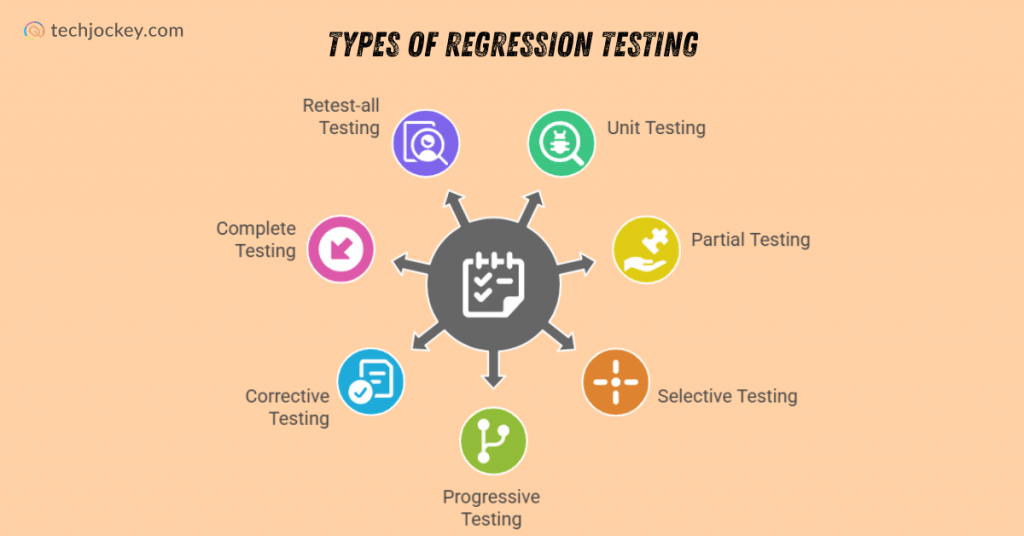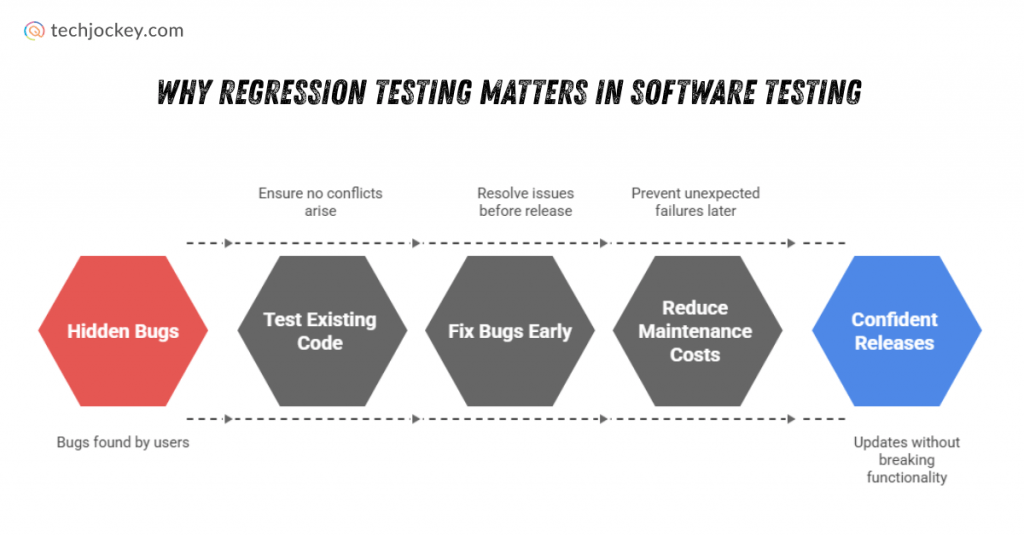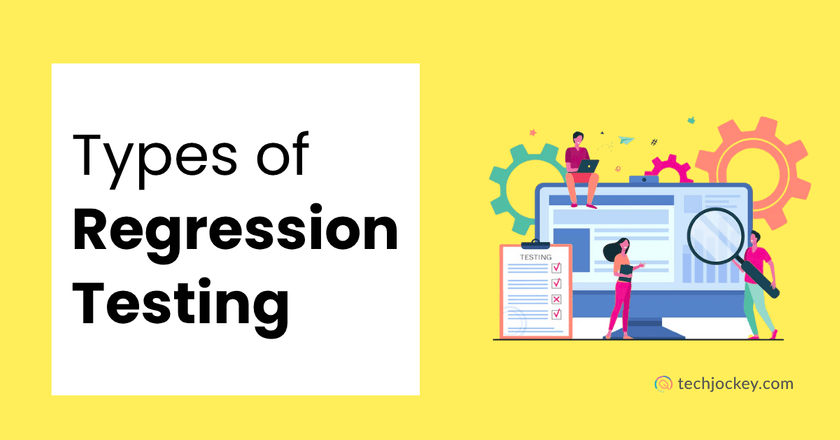No software product can remain static; it will always evolve with new features. This could include fixing bugs, improving product performance, etc.
However, with these changes, there’s a risk that your team could accidentally break some previous features that were working fine. In this situation, regression testing plays a crucial role.
Let’s get started with understanding regression testing in detail.
What is Regression Testing?
Regression testing in software engineering is all about re-testing the existing features of a software product after releasing new updates. It’s done to check whether the new features have negatively impacted the previous features or not. If yes, the team has to work again to fix any bugs found during regression testing.
Here’s a regression testing example:
Let’s say you own an e-commerce app, and you run a new feature – “Buy 2, Get 1 Free”.
You have to use regression testing here to avoid any serious issues like:
- Cart totals may calculate incorrectly
- Old coupons might stop working
- The payment gateway could reject wrong amounts
- Invoices or order records might show errors
With regression testing, all the old features like pricing, checkout, and payment are tested again. This is to make sure that the new change doesn’t break anything.
So, in short, regression testing means confirming that old features still work as expected after new code changes.
It helps developers and QA teams:
- Identify bugs early in the development cycle
- Avoid introducing new issues while fixing old ones
- Maintain product stability during frequent updates
Suggested Read: 15 Best Open Source Testing Tools List to Choose From
Different Types of Regression Tests in Software Testing

Regression testing can be performed using several types. It depends on the project size, budget, and timeline. Let’s explain the types of regression testing with examples.
| Type | Scope | Purpose | When to Use |
|---|---|---|---|
| Unit Regression | Single unit (function/module) | Ensures the unit works after changes | Small/local code fixes |
| Partial Regression | Changed modules + dependencies | Verifies new changes integrate well | Localized updates |
| Complete Regression | Entire system | Ensures no area is broken | Before major release |
| Corrective Regression | Existing functionality only | Confirms stability without new features | Routine checks, no new changes |
| Progressive Regression | New + existing code | Validates new features don’t break old ones | Adding new functionality |
| Selective Regression | Subset of impacted test cases | Saves time by testing only affected areas | Time-limited testing cycles |
| Retest-all Regression | All test cases | Maximum coverage, thorough verification | Critical systems, major changes |
1. Unit Regression Testing
By the name, it says that it performs testing for individual units, such as a function, method, or module, without unifying them into the larger system.
When it’s performed:
During the coding phase, right after writing or modifying a small code unit.
Unit Regression Testing Example:
Suppose you write a function to calculate tax. A unit regression test ensures it works correctly before integrating it with the rest of the billing system.
Benefits:
- Detects issues early
- Helps developers understand code behavior
- Simplifies future changes
Drawbacks:
- Requires time to write and maintain test cases
- May not detect integration issues
2. Partial Regression Testing
This performs testing whenever the developer adds new code to an existing code. It ensures the newly added part doesn’t negatively impact existing features.
When it’s performed:
After code changes are added, and after conducting an impact analysis.
Partial Regression Testing Example:
Adding a new field in a user profile form. Partial regression testing checks that the existing fields and functions still work.
Benefits:
- Protects existing features
- Saves time by testing only affected parts
Drawbacks:
- Needs to be repeated for every code change
- More complex changes need more complex tests
3. Selective Regression Testing
Selective regression testing means running tests on selected use cases related to the changed code and its dependencies.
When it’s performed:
After new code is added, and you identify specific areas affected.
Selective Regression Testing Example:
If you change a calculation logic in billing, selective regression tests will cover billing-related modules and skip unrelated parts like the user login system.
Benefits:
- Saves resources by avoiding unnecessary tests
- Focuses on relevant parts
Drawbacks:
- Requires careful selection of test cases
- Manual effort can be significant
4. Progressive Regression Testing
Used when new features are added or existing specifications change, requiring new test cases alongside old ones.
When it’s performed:
When product requirements or design specs change.
Progressive Regression Testing Example:
Adding a “wishlist” feature to an e-commerce app. New test cases ensure wishlist functionality works and doesn’t impact existing cart or payment modules.
Benefits:
- Confirms updates don’t break existing functionality
- Adapts tests to changing requirements
Drawbacks:
- Creating new test cases requires developer time
5. Corrective Regression Testing
Applied when no changes are made to the product’s core specs or code, but existing test cases are rerun to verify functionality.
When it’s performed:
When there’s a need to validate that the software still behaves correctly, even without recent changes.
Corrective Regression Testing Example:
Before a minor patch release with no new features.
Benefits:
- Simple and cost-effective
- Reuses existing test cases
Drawbacks:
- May feel repetitive for testers
6. Complete Regression Testing
Used when major code changes occur that could affect the core system. Tests cover the entire application.
When it’s performed:
After large updates or before a major release.
Complete Regression Testing Example:
Rewriting the backend architecture or changing the database system.
Benefits:
- High confidence in product stability
- Catches unexpected issues
Drawbacks:
- Time-consuming and resource-intensive
7. Retest-all Regression Testing
The most thorough approach: re-execute all test cases, comparing current outcomes with previous results.
When it’s performed:
When you suspect something critical might have been missed earlier or before significant releases.
Retest-all Regression Testing Example:
After integrating multiple modules developed separately.
Benefits:
- Ensures complete coverage
- Minimizes the risk of hidden bugs
Drawbacks:
- Very time-consuming
- Can lead to longer release cycles
Why Regression Testing Matters in Software Testing?

There’s a need to keep applications updated with advancements in technology. But it’s always risky to update the fresh code as it could conflict with the existing code. Teams use regression testing to fix this, but if it is not used:
- Bugs remain hidden until users find them (leading to poor reviews or loss of trust)
- Fixes might create new bugs elsewhere
- Maintenance costs rise due to unexpected failures
That’s why regression testing in software testing is considered a backbone of quality assurance. It helps teams confidently release updates while protecting what already works.
Top Regression Testing Tools
It’s tough for teams to execute a number of test cases manually; thus, the need for a regression testing software becomes important.
Below are some popularly used tools:
Playwright: Playwright is an open-source automation library by Microsoft for browser testing. It supports Chromium, Firefox, and WebKit using a single API, enabling reliable end-to-end tests in headless or non-headless modes.

Playwright
Starting Price
Price on Request
Cypress: Cypress is a development-friendly, test execution tool with a fast front-end interface. It provides real-time reloading and visual test runners, which makes it easy to debug.

Cypress
Starting Price
$ 75.00
Selenium: Selenium is a time-tested option to automate the testing of browsers across various programming languages and browsers.

Selenium
Starting Price
Price on Request
BrowserStack: BrowserStack is a cloud-based solution to execute automated front-end tests on real devices and browsers without needing any local test environment.

Browserstack
Starting Price
$ 29.00
Leapwork: Leapwork is a no-code tool that allows teams to easily create test flows visually without requiring extensive programming experience.

LeapWork
Starting Price
Price on Request
All the above tools can save your precious time and make testing faster and reliable than before.
Final Thoughts on Types of Regression Testing
Regression testing is not only about re-running tests on previous features; it also involves the practice of providing a better user experience.
Brainstorming can help the tech teams choose the right type of regression testing before implementing it. They can match their approach to project needs, timeline, and risk.
So, the next time your team launches a new feature, don’t forget that regression testing paves the way to smooth updates.
Mehlika Bathla is a passionate content writer who turns complex tech ideas into simple words. For over 4 years in the tech industry, she has crafted helpful content like technical documentation, user guides, UX content, website content, social media copies, and SEO-driven blogs. She is highly skilled in... Read more









